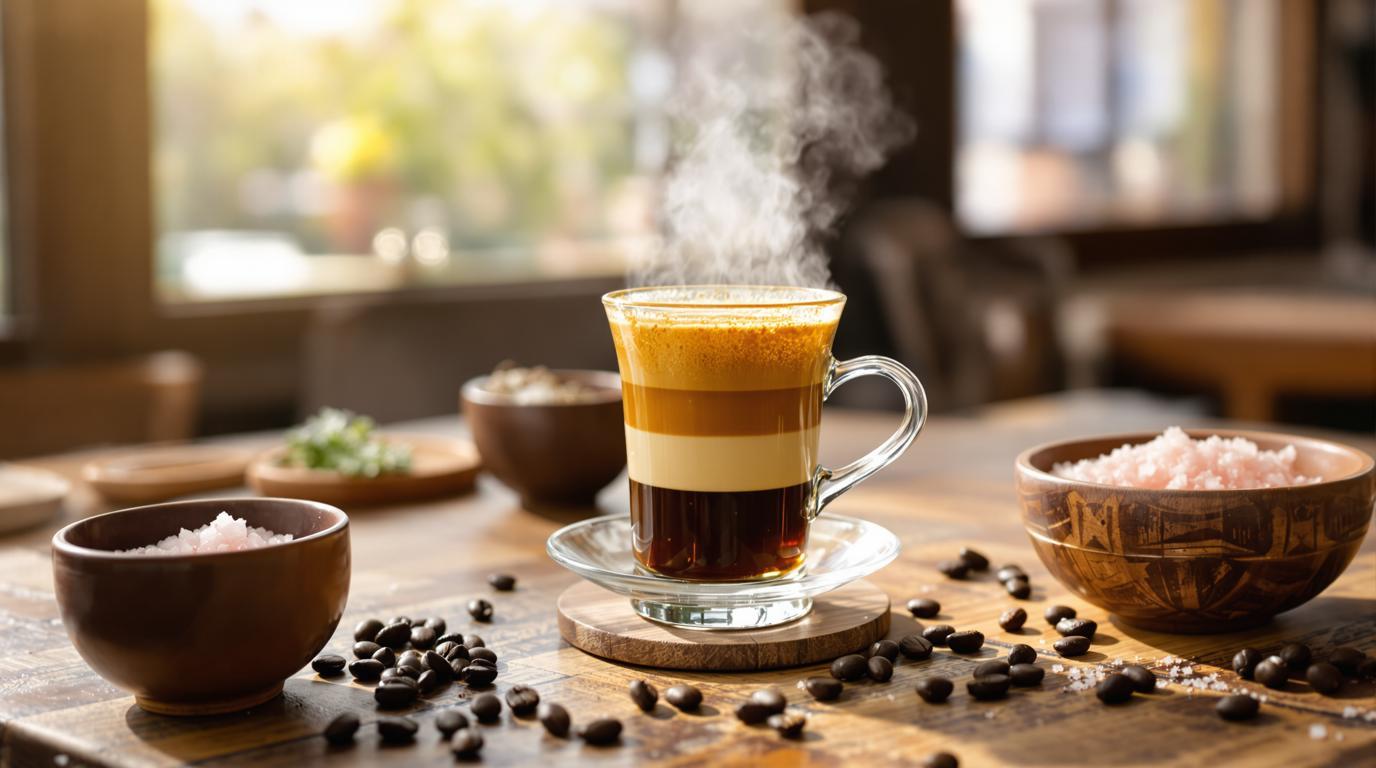Growing up, my grandmother would whisper kitchen secrets that seemed almost magical. One of her most surprising was adding a pinch of salt to her morning coffee. “It cuts the bitterness,” she would say with a knowing smile. Years later, during my culinary travels through Vietnam, I discovered this wasn’t just Grandma’s trick – it was an established tradition in Hue’s coffee culture. Vietnamese salted coffee, or cà phê muối, transforms ordinary coffee into something extraordinary through this simple yet profound technique. The science is fascinating – sodium ions actually neutralize bitter compounds while enhancing the natural sweetness in coffee beans. The result? A perfectly balanced cup with caramel notes that might forever change how you brew your morning cup.
The Heritage of Vietnamese Salted Coffee ☕
Salted coffee originated in Hue, Vietnam’s former imperial capital, about a decade ago. Unlike the sweeter Vietnamese coffee preparations popular in Hanoi or Ho Chi Minh City, Hue’s version embraces a more complex flavor profile. Traditional families have been adding salt to robusta beans (Vietnam’s primary coffee crop) for generations to tame their naturally intense, bitter character. What began as a practical solution has evolved into a celebrated culinary tradition that perfectly encapsulates Vietnam’s genius for balancing contrasting flavors.
The traditional preparation uses a phin filter – a small metal brewing device that sits atop your cup, allowing coffee to slowly drip through grounds. This unhurried extraction is essential to the drink’s character and creates a moment of mindfulness in Vietnamese coffee culture.
Essential Ingredients 🧾
For an authentic cup of Vietnamese salted coffee, you’ll need:
- 25-30g (4 Tbsp) medium-ground Robusta coffee
- 4-6g (¾-1 tsp) fine sea salt or Himalayan pink salt
- 20-25ml (4-5 tsp) sweetened condensed milk
- 95ml (⅓ cup) water heated to 95°C/203°F
Chef’s Note: The type of salt matters tremendously here. Avoid iodized table salt, which can impart a metallic flavor. Sea salt or pink Himalayan salt provides a cleaner taste that enhances rather than competes with the coffee notes.
Traditional Brewing Method 📝
- Rinse your phin filter with boiling water to preheat it – this stabilizes the brewing temperature and ensures even extraction.
- Mix your ground coffee with salt directly in the phin filter, stirring gently to distribute evenly.
- Place the phin over your cup containing condensed milk.
- Pour about 20ml of hot water to allow the coffee to “bloom” for 30 seconds – you’ll see it expand as carbon dioxide releases.
- Slowly add the remaining water in a circular motion, then place the filter cap on top.
- Allow the coffee to drip through completely (4-5 minutes) – patience rewards you with perfect extraction.
- Stir thoroughly to incorporate the condensed milk into the finished brew.
Chef’s Secret Techniques 🤫
The magic of this preparation lies in understanding extraction fundamentals. A medium-coarse grind similar to what you’d use for a French press prevents over-extraction and bitterness. The slow drip method allows the salt to work its chemical magic, neutralizing bitter compounds while enhancing the natural caramel notes in the coffee.
In traditional households, some families add crushed, cleaned eggshells to the filter – a technique my own grandmother used with regular coffee. The calcium carbonate in eggshells further reduces acidity and adds a silky mouthfeel to the finished brew. If you’re feeling adventurous, try adding a small piece of cleaned, crushed eggshell to your filter along with the grounds and salt.
Don’t have a phin filter? While not quite the same, you can approximate this technique using a French press. Add your coffee and salt to the press, pour hot water, stir gently, and let steep for 4 minutes before pressing. The texture will differ slightly, but the flavor profile remains wonderful. Check out this technique for other adaptable kitchen methods.
Modern Variations and Serving Suggestions 🍽️
For a contemporary twist that’s gaining popularity in Vietnamese cafés, try the salted cream topping variation. Whip 100ml heavy cream with 2g salt until stiff peaks form, then float this atop iced coffee sweetened with condensed milk. The contrast between the cold, sweet coffee and the savory cream layer creates a delightful sensory experience reminiscent of this silky preparation.
In Hue, salted coffee is traditionally enjoyed mid-morning as a moment of respite, often accompanied by bánh bèo (steamed rice cakes) or bánh pía (flaky pastries). For a Western pairing, I find that simple chocolate desserts or fudgy brownies complement the complex flavors beautifully, while fluffy pancakes make an excellent breakfast companion.
This little-known coffee preparation exemplifies what I love most about culinary traditions – their ability to transform something familiar into something transcendent through a simple twist. In our rush for novelty, sometimes we overlook the profound wisdom contained in these heritage techniques. So tomorrow morning, try adding that pinch of salt to your coffee – you might just discover what Vietnamese coffee lovers and my grandmother have known all along.
